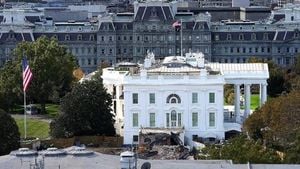As the government shutdown stretches into its fourth week, the fate of America’s national parks and public lands has become a flashpoint of debate, anxiety, and even a little ingenuity. In Marin County, California, Muir Woods National Monument—famous for its towering redwoods—has reopened its gates to visitors, but not thanks to federal intervention. Instead, a coalition of private donors, park concessionaires, and vendors have stepped in, raising enough funds to keep the park open with free admission through October 31, 2025, according to ABC7 News.
This rare move has brought both locals and tourists flocking to the ancient forest. Volunteer John Maclennan captured the mood, saying, “It feels great, I’m glad people have heard about the opening they came back.” For many, like Laila Mohamed from Raleigh, North Carolina, the reopening was an unexpected delight. “I’m really grateful, my mom went on a tour earlier this week and they weren’t able to come in because it was closed. I fully expected we weren’t going, but they said Muir Woods is open, I was so happy,” she told ABC7.
The shutdown, which began on October 1, 2025, has shuttered many federal services across the country. Muir Woods was closed for most of October, and its reopening remains only temporary. The Golden Gate National Parks Conservancy explained that the park’s revival was made possible by a group of concessionaires and vendors pooling resources to keep staff and volunteers on-site. Nature guides have returned, eager to share the wonders of the redwoods, while visitors marvel at the trees’ grandeur—some nearly tripping over their own feet as they gaze upward.
It’s not just Muir Woods benefiting from private support. Alcatraz Island, another Bay Area icon, has kept its tours running during the shutdown thanks to a donation from Hornblower Cruises, the ferry operator. Leah Chopan, a visitor from Dallas, shared her excitement: “I went yesterday to Alcatraz, I even met a former inmate, Baker.”
Yet, for every success story, there are mounting concerns. Across the nation, roughly 80% of America’s 430 National Park sites remain open in some capacity, but most are operating with severely reduced staffing. According to States Newsroom, the National Park Service (NPS) furloughed more than 9,000 of its approximately 14,500 workers at the start of the shutdown. The result? Staff who would typically be focused on protecting irreplaceable resources or maintaining trails are now cleaning visitor centers and managing parking lots. John Garder, senior director of budget and appropriations at the National Parks Conservation Association (NPCA), described the situation as creating “a facade for the visitors, so that in many cases they don’t see the damage that’s happening behind the scenes.”
This “bare-bones staffing,” as advocates call it, has already led to troubling reports. At Yosemite National Park in California, illegal camping and BASE jumping have been documented—activities that can cause lasting harm to delicate ecosystems. The Coalition to Protect America’s National Parks issued a statement warning, “Keeping parks open without adequate staff is in violation of the National Park Service’s founding mission and inconsistent with the laws passed by Congress. We recognize that closing parks is not an easy decision but it’s the responsible one.”
Others in the conservation community have echoed these sentiments. Aaron Weiss, deputy director of the Center for Western Priorities, likened the current situation to “allowing visitors to ramble through an unstaffed Smithsonian museum.” He argued, “This would be like the Smithsonian saying, ‘Well, you know, we don’t have the staff to keep the Smithsonian museum staffed, but we’ll go ahead and leave the gates, the doors open, and come in and take a look, do what you want.’ That would be horrifically irresponsible of the Smithsonian, but that is exactly what the National Park Service is saying.”
The problem is compounded by the sheer size and openness of many park sites. The largest parks, with sprawling landscapes, lack comprehensive fencing or barriers, making it nearly impossible to keep visitors out even if closures were attempted. Public lands managed by the Bureau of Land Management (BLM) and the U.S. Forest Service are even less likely to have entry controls. In the meantime, BLM spokeswoman Alyse Sharpe emphasized that the agency would “keep public lands as accessible as possible” during the shutdown, maintaining “critical functions that protect life, property, and public health.”
The Interior Department, under Secretary Doug Burgum, has prioritized keeping parks open, even transferring funds earmarked for maintenance to operations—a controversial move. In a Fox News interview on October 14, Burgum pointed fingers at congressional Democrats, saying, “Of course, all of our many sites… would be better operated and better staffed if the Senate would just get us back in the government. Way to go, Senate Democrats.” Democrats, for their part, have insisted on negotiating over expiring health care tax credits as a condition for passing a stopgap spending bill to reopen the government.
While the political blame game rages, the shutdown’s impact on federal employees is unmistakable. More than half of the Interior Department’s nearly 60,000 employees have been furloughed, adding to a growing sense of demoralization among public lands staff. Chris Tollefson, a former communications official at the BLM and Fish and Wildlife Service, reflected, “The people I know get into this because they care passionately about the land and about the resources they protect… it’s really demoralizing to feel like your life’s work has been devalued and that what you’re doing doesn’t matter.”
One furloughed worker, who requested anonymity, put it bluntly: “I came to the government to get a little bit more stability, thinking that it was going to be a safer bet… And that has definitely not been the case. It’s not felt as stable as other positions.” She warned that the perception of instability could make federal jobs less attractive to future talent.
Adding fuel to the fire, oil and gas permitting has continued almost unabated throughout the shutdown. As of October 15, the BLM had issued an average of 19.8 oil and gas permits per day since the shutdown began—matching or exceeding typical monthly rates, according to Weiss’s analysis. “It’s a statement of values,” Weiss argued. “The Interior Department is telling the agency and telling America, ‘The folks who manage drilling on public lands are more important than the folks who actually do the day-to-day caring for our public lands.’” The Interior Department even posted to Instagram on the first day of the shutdown, assuring the public it would continue “issuing permits and other efforts related to American Energy Dominance.”
For now, the story of America’s national parks during the shutdown is one of improvisation, frustration, and uneasy compromise. Temporary solutions like those at Muir Woods and Alcatraz provide a glimmer of hope, but advocates warn that without a fully funded and staffed National Park Service, the nation’s natural treasures remain at risk—sometimes in ways visitors may never see.




